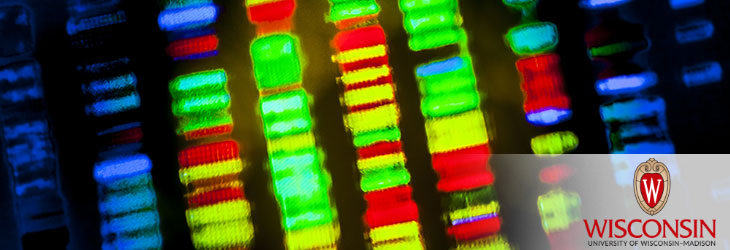Diagnostics & Biomarkers

Sensitive Assay for Detecting Botulinum Neurotoxin, Neutralizing Antibodies or Inhibitors
WARF: P07412US
Inventors: Eric Johnson, Sabine Pellett, William Tepp, Gary Borodic, David Beebe, Amy Paguirigan
The Wisconsin Alumni Research Foundation (WARF) is seeking commercial partners interested in developing a highly sensitive method of analyzing a sample for the presence or activity of botulinum neurotoxin, antibodies specific for botulinum neurotoxin or inhibitors of the toxin.
Overview
Botulinum toxin is used for cosmetic procedures and to treat neurological disorders from spasmodic disorders to chronic pain syndromes. The most widely used form of botulinum toxin is the serotype A complex known as BOTOX.
A single administration of BOTOX generally remains effective for four to five months before another dose is needed. However, many individuals develop immunity to the toxin after repeat dosing, making the injections less effective.
To determine if an individual has developed neutralizing antibodies to botulinum toxin, a mouse-based assay currently is used. Although this test is well-established and quantitative, it can take up to four days and is expensive and technically demanding. Alternative ways of assessing the presence of botulinum neurotoxin or its antibodies are needed.
A single administration of BOTOX generally remains effective for four to five months before another dose is needed. However, many individuals develop immunity to the toxin after repeat dosing, making the injections less effective.
To determine if an individual has developed neutralizing antibodies to botulinum toxin, a mouse-based assay currently is used. Although this test is well-established and quantitative, it can take up to four days and is expensive and technically demanding. Alternative ways of assessing the presence of botulinum neurotoxin or its antibodies are needed.
The Invention
UW-Madison researchers have developed a sensitive and specific method of detecting the presence or activity of botulinum neurotoxin, neutralizing antibodies to the toxin or inhibitors of botulinum toxin. This method may provide a viable alternative to the mouse bioassay.
To detect neutralizing antibodies or other inhibitors of botulinum toxin, the method involves exposing cultured neuronal cells to the toxin and a test sample. The cells are incubated to allow active toxin to cleave an endogenous substrate. Then the cells are harvested and probed to determine how much substrate was cleaved. The more neutralizing antibodies or other inhibitors there are, the less cleavage is observed as compared to the control.
To detect the presence of active neurotoxin, the cultured cells are exposed to a test sample and control samples with known amounts of toxin. The amount of substrate cleavage can be evaluated to determine how much botulinum neurotoxin is present in the test sample as compared to the control samples.
To detect neutralizing antibodies or other inhibitors of botulinum toxin, the method involves exposing cultured neuronal cells to the toxin and a test sample. The cells are incubated to allow active toxin to cleave an endogenous substrate. Then the cells are harvested and probed to determine how much substrate was cleaved. The more neutralizing antibodies or other inhibitors there are, the less cleavage is observed as compared to the control.
To detect the presence of active neurotoxin, the cultured cells are exposed to a test sample and control samples with known amounts of toxin. The amount of substrate cleavage can be evaluated to determine how much botulinum neurotoxin is present in the test sample as compared to the control samples.
Applications
- Detecting botulinum toxin neutralizing antibodies
- Detecting botulinum neurotoxin
- Evaluating botulinum toxin inhibitors
- Evaluating improvements to botulinum neurotoxin formulations
Key Benefits
- Capable of detecting as little as 0.000091 IU of neutralizing antibodies, which is 10 times more sensitive than the current mouse bioassay
- Capable of detecting as little as 33 fM botulinum toxin, which is approximately 0.1 mouse LD50 units
- Represents the closest approximation of the in vivo interactions that are essential to the pharmacologic action of botulinum toxin—measures external receptor binding, internalization and lysis of the cytoplasmic substrate
- Can be used widely in clinical and drug development settings
- Works with all serotypes of botulinum toxin
- Suitable for medium throughput analysis in microtiter plates
- Harvested cells can be kept in culture up to eight or nine months.
- Reduces the use and suffering of animals as compared to the standard mouse bioassay
- Test samples may include an individual’s serum, blood, plasma or tissue; foods; preparations of botulinum toxins; potential inhibitors; or laboratory-produced antibodies, such as vaccines.
Stage of Development
Samples containing neutralizing antibodies were successfully and quantitatively identified in a blind study using this method. This assay also was used successfully to evaluate toosendanin as a botulinum toxin A inhibitor.
Additional Information
For More Information About the Inventors
Publications
- Pellett S., Tepp W.H., Clancy C.M., Borodic G.E. and Johnson E.A. 2007. A Neuronal Cell-Based Neurotoxin Assay for Highly Sensitive and Specific Detection of Neutralizing Serum Antibodies. FEBS Lett. 581, 4803–4808.
Tech Fields
For current licensing status, please contact Andy DeTienne at [javascript protected email address] or 608-960-9857